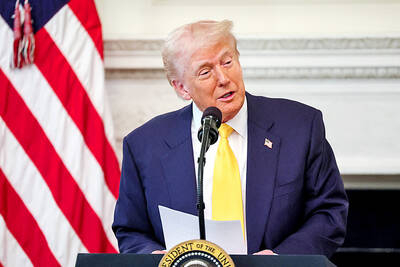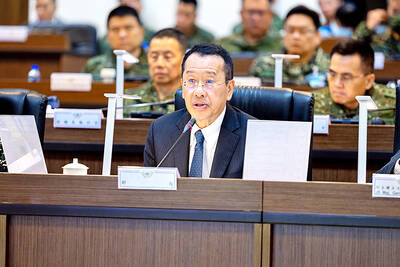The Executive Yuan has proposed to increase next year’s budget for the “five trusted industry sectors” by 40.6 percent compared with this year, with NT$12.2 billion (US$379.9 million) appropriated for the semiconductor industry.
A total of NT$21 billion is to be allocated to the “five trusted industry sectors” — semiconductors, artificial intelligence (AI), military defense, security and surveillance, and next-generation communications — for next year, in addition to the NT$1.2 billion dedicated to the fifth phase of the Forward-looking Infrastructure Development Program, totaling NT$22.2 billion, the Directorate-General of Budget, Accounting and Statistics said in a report.
The total budget increased by NT$6.4 billion, or about 40.6 percent, from this year, it said.

Photo: Bloomberg
The budget is crucial to plan the next stage of the nation’s industrial development and on Friday it was sent to legislative committees for review, it said.
The semiconductor sector is to receive NT$12.2 billion, up from NT$10.1 billion, a year-on-year increase of 21.2 percent.
The Ministry of Economic Affairs (MOEA) would receive NT$7.05 billion, mainly to fund projects related to the Taiwan Chip-based Industrial Innovation Program.
The National Science and Technology Council (NSTC) is to receive NT$4.93 billion, the report said.
The budget for the AI sector is to be boosted by 134 percent to NT$7.4 billion next year from NT$3.2 billion this year, with NT$4.8 billion allocated to the NSTC, NT$1.47 billion to the MOEA and NT$810 million to the Ministry of Digital Affairs (MODA).
The NSTC would focus on high-performance computer architecture, AI development and setting up an AI computing data center.
The NT$1.4 billion next-generation communications sector budget consists of NT$820 million allocated to the MOEA — to aid chip-based innovations, and international collaborations and experiments in the sixth-generation wireless industry — NT$480 million to the NSTC for the development of low Earth orbit satellites and NT$100 million to the MODA.
The MODA would also receive NT$600 million to improve interdisciplinary and integrated cybersecurity, and chip-based resilience.
The MOEA would get NT$600 million to construct indigenous warplanes and warships, develop an Asian innovation and incubation center and establish a maintenance center for F-16 Falcon aircraft, the report said.
The latest National Development Plan from next year to 2028 has set the gross output value goals for the “five trusted industry sectors,” including a NT$2.66 trillion increase in output value and additional 250,000 job opportunities for the semiconductor sector by 2028, and an output value of up to NT$1 trillion for the AI sector by 2026.
The government also set goals of output value of more than NT$130 billion for the security monitoring and cybersecurity industry, NT$30 billion for the satellite communications industry, and NT$30 billion for the military drone industry.

STILL COMMITTED: The US opposes any forced change to the ‘status quo’ in the Strait, but also does not seek conflict, US Secretary of State Marco Rubio said US President Donald Trump’s administration released US$5.3 billion in previously frozen foreign aid, including US$870 million in security exemptions for programs in Taiwan, a list of exemptions reviewed by Reuters showed. Trump ordered a 90-day pause on foreign aid shortly after taking office on Jan. 20, halting funding for everything from programs that fight starvation and deadly diseases to providing shelters for millions of displaced people across the globe. US Secretary of State Marco Rubio, who has said that all foreign assistance must align with Trump’s “America First” priorities, issued waivers late last month on military aid to Israel and Egypt, the

‘UNITED FRONT’ FRONTS: Barring contact with Huaqiao and Jinan universities is needed to stop China targeting Taiwanese students, the education minister said Taiwan has blacklisted two Chinese universities from conducting academic exchange programs in the nation after reports that the institutes are arms of Beijing’s United Front Work Department, Minister of Education Cheng Ying-yao (鄭英耀) said in an exclusive interview with the Chinese-language Liberty Times (the Taipei Times’ sister paper) published yesterday. China’s Huaqiao University in Xiamen and Quanzhou, as well as Jinan University in Guangzhou, which have 600 and 1,500 Taiwanese on their rolls respectively, are under direct control of the Chinese government’s political warfare branch, Cheng said, citing reports by national security officials. A comprehensive ban on Taiwanese institutions collaborating or

France’s nuclear-powered aircraft carrier and accompanying warships were in the Philippines yesterday after holding combat drills with Philippine forces in the disputed South China Sea in a show of firepower that would likely antagonize China. The Charles de Gaulle on Friday docked at Subic Bay, a former US naval base northwest of Manila, for a break after more than two months of deployment in the Indo-Pacific region. The French carrier engaged with security allies for contingency readiness and to promote regional security, including with Philippine forces, navy ships and fighter jets. They held anti-submarine warfare drills and aerial combat training on Friday in

COMBAT READINESS: The military is reviewing weaponry, personnel resources, and mobilization and recovery forces to adjust defense strategies, the defense minister said The military has released a photograph of Minister of National Defense Wellington Koo (顧立雄) appearing to sit beside a US general during the annual Han Kuang military exercises on Friday last week in a historic first. In the photo, Koo, who was presiding over the drills with high-level officers, appears to be sitting next to US Marine Corps Major General Jay Bargeron, the director of strategic planning and policy of the US Indo-Pacific Command, although only Bargeron’s name tag is visible in the seat as “J5 Maj General.” It is the first time the military has released a photo of an active